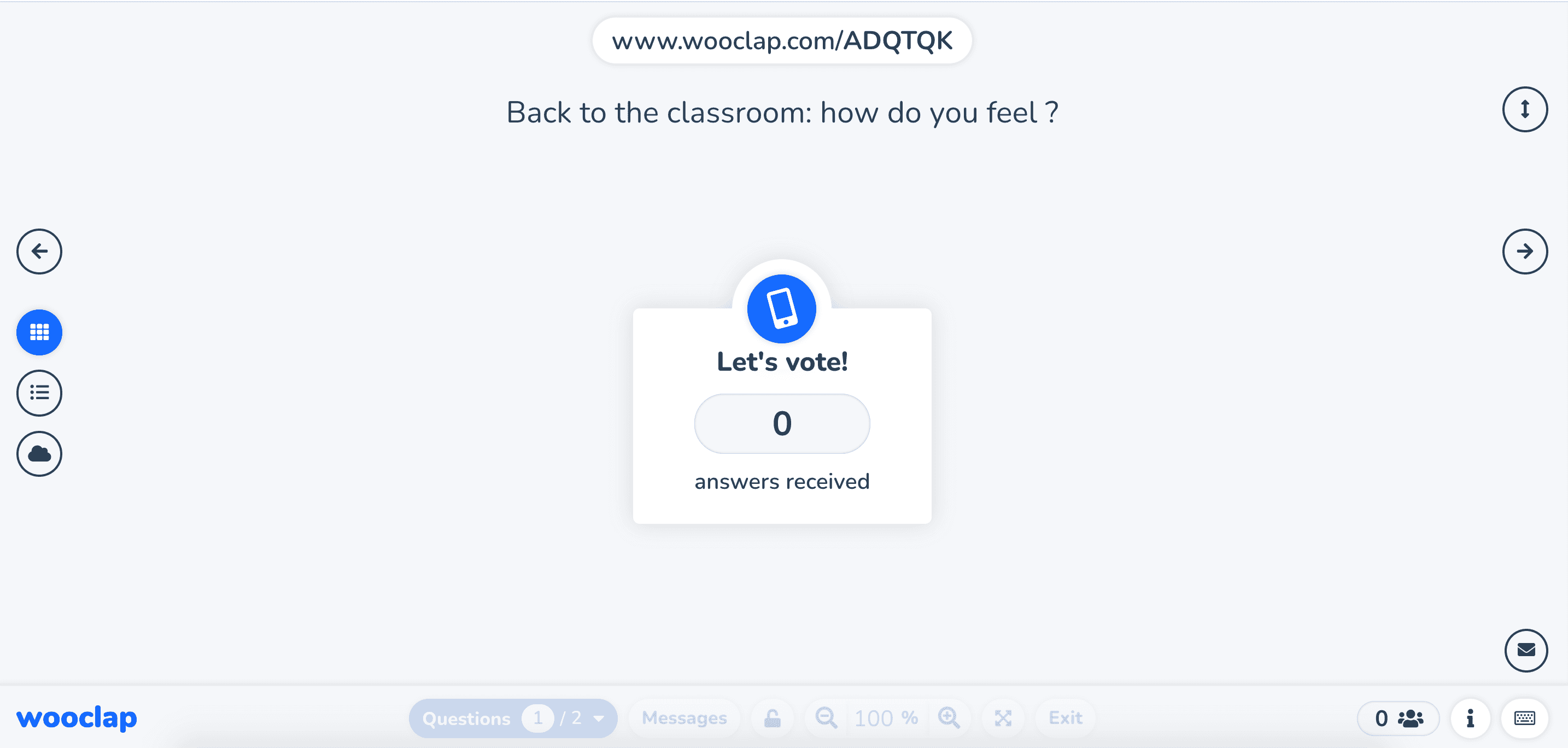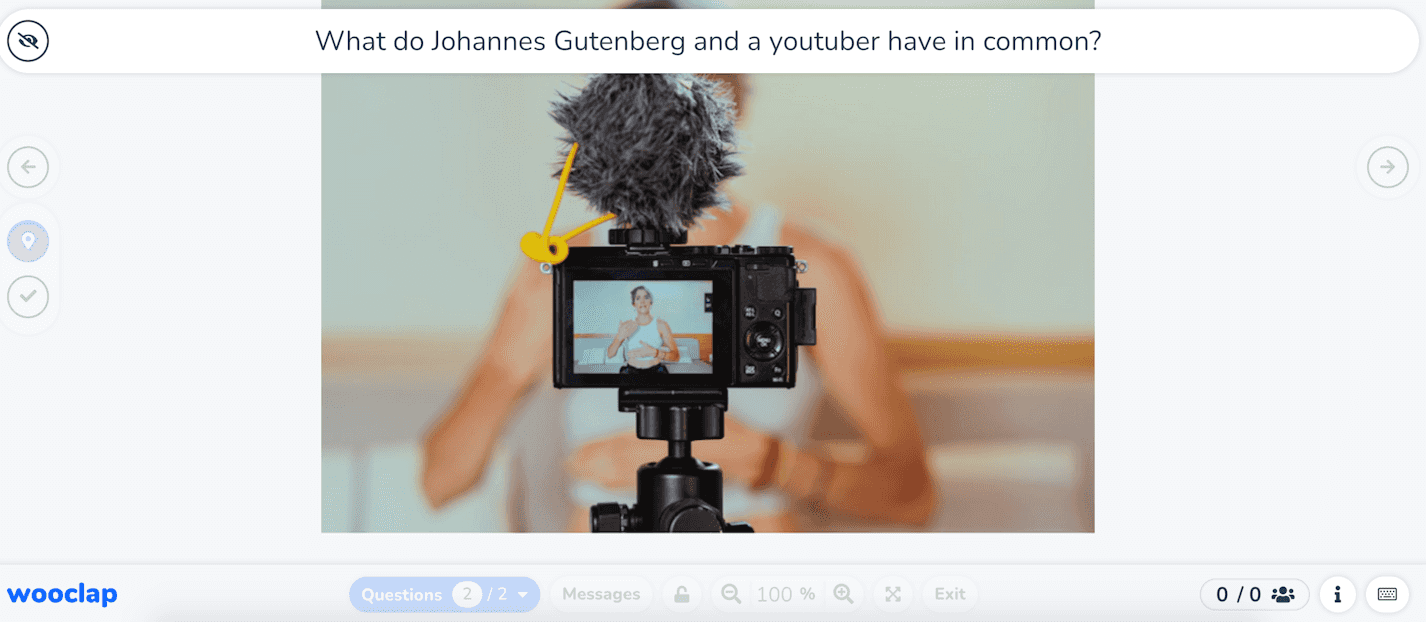
American summer tour! Wooclap will be at Anthology Together 2025
Come say hi at booth 301 from July 14th to July 16th in Las Vegas, Nevada
Back to the classroom in 2021
22.09.2021 • 4 minutes

Helping Students Transition Back to Face-to-Face Learning
For many people, university is the best time of their lives. However, if we ask the new generations today, their answer is likely to be different.
The faculty, the lectures in large lecture halls, the fun talks in the cafeteria afterwards... The COVID-19 pandemic has meant a break in one of the greatest attractions of the university experience: face-to-face classes.
Fortunately, with the advent of vaccines, new measures and the integration of flexible teaching models for teachers and students, everything is about to change for the Quaranteens. The return to the classroom in 2021 is finally a reality.
To be ready for this new beginning, in this article we will unveil the main challenges for teachers in dealing with students who have never seen campus in real life, and give the keys to make their transition to face-to-face teaching as smooth as possible.
Let's get started!
1. Coming to terms with the new reality
In a period that would normally have been filled with celebrations, the class of 2020 felt a mixture of emotions: trapped, disoriented, lost or even relieved.
Therefore, normalising and validating all the emotions, both positive and negative, that students may have about returning to class is a priority and discussing their concerns about this new situation is almost an obligation. This open dialogue is the first step in finding the right tools to solve their problems in a logical and creative way, improving the performance of the class and making it more human.

Example Wooclap: open question to break the ice and encourage students to anonymously share their feelings.
2. Humanising the classroom
Before students connect with the content of the lesson, it is important that they connect with the person telling them about it. Now more than ever, the "face-to-face" without screens in between is a powerful medium to strengthen the teacher-student bond and to allow for a closer and more immediate interaction (but always keeping a safe distance, of course!).
In this way, by establishing a closer relationship with the students, getting to know them and allowing them to get to know you, the teacher will be better prepared to apply the content of the class to their lives and make the teaching-learning process much more enjoyable and fun. Because, as the poet Alfred Mercier said: "What we learn with joy is never forgotten".

Wooclap example: the teacher uses the popular figure of the youtuber to talk about the media revolution and capture the attention of the audience.
3. Setting expectations for participation
After so much time, students may be worried about how they will interact with their teachers, and this uncertainty often makes them hesitant to speak in class. This self-censorship, coupled with the effort of returning to face-to-face life, is an obstacle to collective learning and the exchange of ideas.
To combat this, the teacher must create a safe and accessible classroom climate in which students know it is OK to speak up and make participation a requirement from the outset. Here are some ways to achieve this:
- The teacher's position in the classroom. Moving away from the front of the classroom can sometimes promote better participation. If students perceive that all comments must go through the teacher, the teacher becomes a kind of gatekeeper to participation and it is more difficult to promote a sense of collective responsibility. Try moving to the side or even to the back of the room and observe how students respond.
- Peer grading. You can let students grade each other on their participation in class. Peer grading not only motivates students to participate, but also provides a detailed record of how students contributed to their peers' learning throughout the course.
- Wooclap - this one was obvious! The platform is the best example of leveraging technology in the classroom. You can use Wooclap to actively engage students in the classroom by asking them to answer different interactive questions from time to time via their smartphones, tablets or computers.
Capturing students' attention is one of the biggest challenges for almost every teacher in the world. But with effort and the right strategies, you can do it!
4. Varying the pace of lessons
Considering that students will have to concentrate more in a less comfortable environment, getting them used to varied and dynamic classroom activities is the best solution. Therefore, long lessons based on passive listening in the classroom should be avoided. Instead, and by putting the previous sections into practice, here are some ways to break up lessons by changing the topic or mode of teaching:
- Short videos. You can play a YouTube video related to the theory in class and have students respond to it.
- Quick questions. From time to time, you can poll the class to get students' quick responses to a particular question or topic.
- Group work. Ask students to work in teams and then share what they have done with the rest of the class via the Wooclap Brainstorming question. This practice not only promotes learning, but also facilitates new friendships, one of the most precious parts of the university experience.
Big problems, big solutions
If the pandemic has taught us anything, it is that we are able to adapt to whatever comes our way, no matter how fast or disorienting the process may be. So, whether remote or face-to-face, the connection between teacher and student will always find a way to be there to ensure proper learning and meet the needs of their students.
With the help of tools like Wooclap and the use of more dynamic and student-centred methodologies, it is already possible to arouse the curiosity of students to participate and adapt to the classes, so the way of teaching does not necessarily change, but the way of approaching students does. And in the best way.
Writer

Julie Lemaire
Content Marketing Lead @Wooclap. As a student of language with a passion for education and a thirst for knowledge, I am currently learning to parlare italiano.
A monthly summary of our product updates and our latest published content, directly in your inbox.



